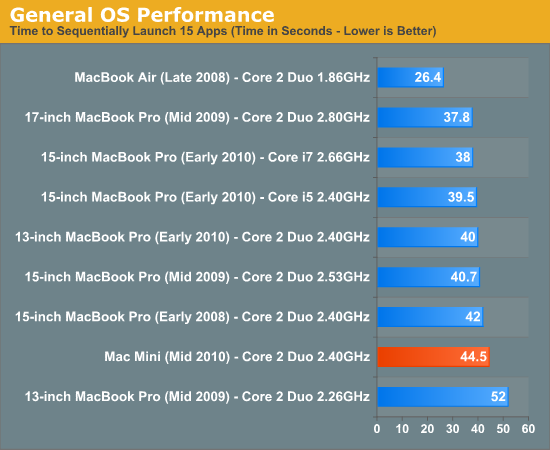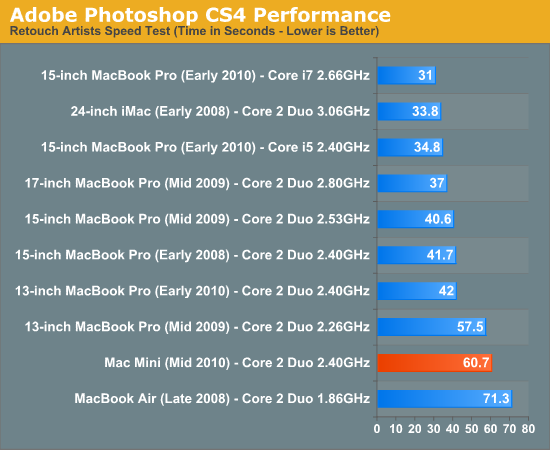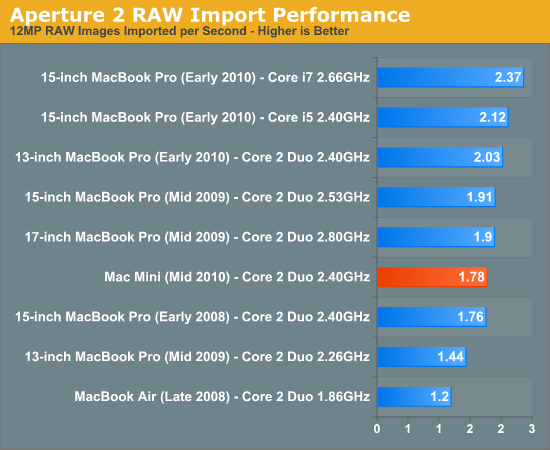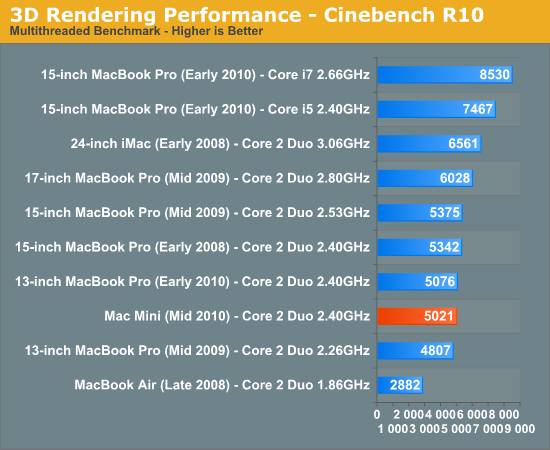Apple Mac mini Review (Mid 2010)
by Anand Lal Shimpi on August 9, 2010 3:37 AM ESTGeneral Performance
The original Mac mini was fast enough for the entry level Mac user back in 2005. Given that Apple’s iPad is fast enough for many users today, I don’t think it’s too difficult to understand that the 2010 Mac mini is sufficient for most needs.
There are two problems with the overall performance of the mini that will contribute to it feeling slow, particularly over time. The first is memory, and I’ll touch on this in more detail later, but 2GB of RAM is simply not sufficient for a computer running a heavyweight OS. Even light multitasking exposes this weakness. The second is the hard drive.
Apple ships the Mac mini with a 2.5” 5400RPM notebook drive. The drive keeps power consumption and noise down to a minimum, while being awful for performance. To Apple’s credit, OS X does a good job of caching frequently used data but without enough RAM this is a wobbly crutch.
The Mac mini is absolutely begging to have an SSD, and unlike the rest of Apple’s Mac lineup, one isn’t even offered on the mini. I’m going to take this opportunity to again plead for Apple to include a decent SSD in its customization options. These days the name of the game is SandForce. While that may change in another quarter or two, we still need Apple to take SSDs more seriously than it has been.
Now on to the numbers. I didn't have any previous generation Intel Mac minis on hand so the performance comparison is mainly to the MacBook/MacBook Pro. I did throw in some results from the early 2008 iMac I reviewed a while back.
General OS Performance
General OS usage is a difficult thing to quantify, but one measure of performance has always been the number of bounces an icon in the dock makes before an application loads. I decided to take it to the next level and write a quick script to launch 15 applications in a row, timing how long the entire process takes.
I launched, in order: Mail, Safari, Activity Monitor, iTunes, iCal, DVD Player, iPhoto, Photo Booth, Quicktime Player, Disk Utility, Preview, iMovie, Front Row, Garage Band and Aperture.
The entire process stresses both the disk and CPU, which is why we see a huge improvement when going to an SSD as well as differences between CPU speeds.

Application launch performance is slower than the 13-inch MacBook Pro because of the mini’s 2GB of memory. You’ll see this trend continuing as we go through our tests.
Adobe Photoshop CS4 Performance
The Retouch Artists Speed Test we use for our CPU testing under Windows also works under OS X. We're running the exact same benchmark here, basically performing a bunch of image manipulations and filters and timing the entire process.

Photoshop performance is decent, but again behind the latest MBPs because we’re swapping to disk. Not only does the mini ship with 2GB of memory but it has to share 256MB with the GeForce 320M.
Aperture 2 RAW Import
For my Aperture test I simply timed how long it took to import 203 12MP RAW images into the library.

Our Aperture test is heavier on the I/O and thus narrows the gap between the 13-inch MBP and the mini.
Cinebench R10
I’m a fan of the Cinebench test because it lets me show off both single and multithreaded performance in the same workload. First, the single threaded performance:


If we’re totally CPU bound, which is the case with Cinebench, you’ll see that the mini performs no differently than the 13-inch MacBook Pro. Compared to a mobile Core i5 you’re looking at roughly 70% of the performance. It’s fast enough, but not speedy.
Quicktime H.264 Video Encoding
Our final benchmark is more consumer focused. Here I'm taking an XviD and converting it to an iPhone-supported H.264 format.

Video encoding performance is once again where we’d expect it to be, roughly on par with the 13-inch MacBook Pro. The new i5 systems are 60% faster.
Maintaining Profit Margins: 2GB vs. 4GB RAM
The $699 mini is the only Mac that currently ships with less than 4GB of memory (except for the MacBook Air). For a $700 system, that’s unacceptable. For a machine that’s sold in 2010, that’s unacceptable. For something that’s not a nettop, well, you get the idea.
The performance gain you see from just adding another 2GB of memory to the 2010 mini is huge. Here’s our Photoshop benchmark before and after an upgrade to 4GB:
| 2010 Mac mini Performance | ||||
| 2GB RAM | 4GB RAM | |||
| Photoshop CS4 Retouch Artists Bench | 60.7 seconds | 42.1 seconds | ||
| Cinebench R11.5 CPU | 1.38 points | 1.39 points | ||
That’s a 44% performance increase! The Cinebench results don't show a similar performance improvement since we're fully CPU bound in an test that easily fits in main memory.
You can argue that not all Mac mini owners won’t be running Photoshop, and I’d even agree with you there, but the memory limits come into play as soon as you start running a couple of large footprint applications. The multitasking falloff is sharp on the Mac mini because you only have 2GB of memory and you’ve got a dirt slow 5400RPM notebook hard drive in there.
The Photoshop results are just to show you something quantifiable. The user experience of the Mac mini is noticeably diminished by only having 2GB of memory.
Upgrading the memory is pretty simple. Just twist the pedestal on the bottom, remove the cover and swap sticks:
Apple ships the mini with 2 x 1GB sticks and the GeForce 320M has a dual-channel DDR3 memory controller so you’ll want to upgrade in pairs as well. Apple charges $100 for the upgrade, which isn’t too bad but you’re better off buying the memory yourself and just eBaying what you get with the system.
You just need to buy DDR3-1066 SO-DIMMs, the same thing you’d put in a notebook.










93 Comments
View All Comments
DaveGirard - Tuesday, August 10, 2010 - link
seriously - I use a Mac Pro Nehalem for Maya and if I had to build a network of headless slaves, this would be an expensive and underperforming option. You could make a vanilla i7 for less and it would destroy this machine for rendering. Nice to see this is a great mini server/HTPC but it's not for performance.name99 - Tuesday, August 10, 2010 - link
Why would you engage in such a stupid enterprise?Apple is NOT selling you a bunch of MIPs here at the lowest possible cost. They are selling you a device that runs MacOSX, with IO options adequate for most users, that is low power and small.
If you do not need any of these capabilities, then buying such a computer is stupid.
Or, to put it another, don't buy a package of, what, 10GFlops AND a reasonable quality GPU AND two video ports AND FW8000 AND OSX AND a small form factor, and then complain that the package costs more than this other package consisting of 10GFlops and nothing else.
But if this device meets your needs, it's great --- I got a previous gen mini for HTPC, and it does what it is meant to do, at a price I found acceptable.
JAS - Monday, August 9, 2010 - link
I bought one of these to run a public kiosk display (Apple Keynote program on a loop). Beyond its good looks, the new Mac Mini provides more than enough horsepower for what most "normal" people use computers for -- web browsers, media playback, e-mail, word processing and so forth. I like how access to the RAM has been made easy and the addition of the HDMI and SD connectors.My only significant criticism of the new Mac Mini is its retail price. It ought to be $50 to $100 less to be considered an "entry level" Macintosh.
nafhan - Monday, August 9, 2010 - link
I agree from a computing aspect, but it really ought to be about $200 - $300 less to be considered a good computer for the average home user. Especially since they will have to spring another $100+ for a monitor/mouse/keyboard right off the bat.Steve W - Monday, August 9, 2010 - link
The idea behind the Mac Mini is that you DON'T have to spring for a "monitor/mouse/keyboard" if you are the average switcher. If you need a monitor, then the iMac is a better buy.Ratman6161 - Tuesday, August 10, 2010 - link
Given that it does not come with those items? The only way you would not need them is if you just happened to already have them. But if you were buying this as a second computer etc that might not be the case.tipoo - Friday, September 10, 2010 - link
Exactly. Once you add a monitor, keyboard and mouse into the price, you are into iMac price territory, and the iMac is still alot faster.LtGoonRush - Monday, August 9, 2010 - link
I don't understand why 7200rpm 2.5" HDDs aren't more popular. The cost difference isn't very large, on a 320GB drive it only amounts to $5. The performance difference isn't Earth-shattering, but given the price of the system it seems hard to justify cutting this corner, along with shaving off 2GB of RAM as called out in the review.Minion4Hire - Monday, August 9, 2010 - link
I've heard both power and noise concerns given as reasons (besides cost as you mentioned) why 7200s aren't as popular. Both are pretty minor, but those are valid reasons.Shark Tek - Monday, August 9, 2010 - link
The main reason of why they aren't popular is a very valid one.HEAT...
A good example is one about the PS3 HD upgrade. They recommend 5400rpm disks due to problems of overheating using a faster one.